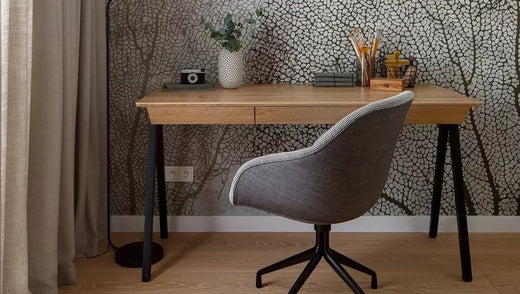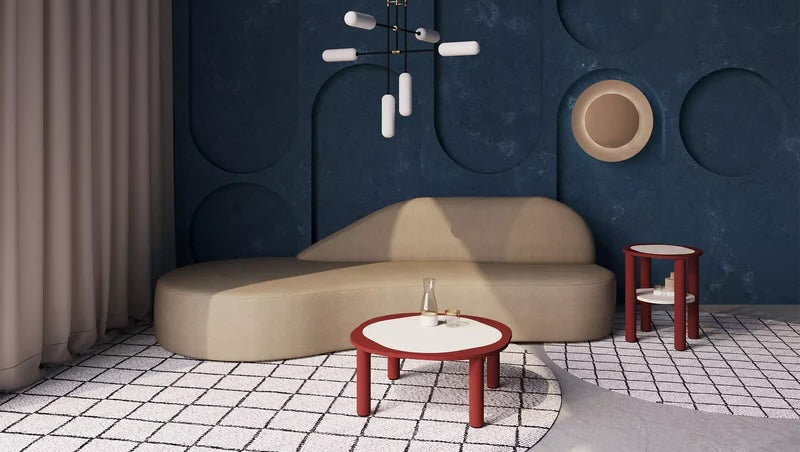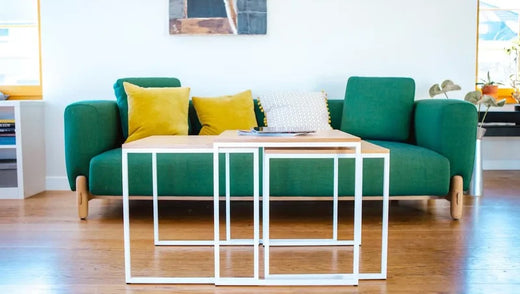Urządzenie ergonomicznego i estetycznego biura w salonie stało się nie tylko trendem, ale wręcz koniecznością. Wydzielone miejsce do pracy w domowym zaciszu pozwala nie tylko na zwiększenie produktywności, ale również na zachowanie granicy między życiem zawodowym a osobistym.
Odpowiednio zaprojektowany kącik biurowy w salonie może stać się miejscem, które inspiruje do kreatywności i pozwala skupić się na wykonywanych zadaniach, bez konieczności rezygnacji z komfortu własnego mieszkania.
Dlaczego warto urządzić miejsce do pracy w salonie?
Salon, jako centralne miejsce w domu, oferuje unikalne możliwości dla zaprojektowania przestrzeni pracy. Połączenie funkcjonalności biura z estetyką salonu pozwala nie tylko na wygodną pracę, ale również na wprowadzenie elementu dekoracyjnego, który wzbogaca wnętrze. Biurka do pracy w domu, dobrze wkomponowane w przestrzeń salonu, mogą stać się nie tylko miejscem do pracy, ale również eleganckim dodatkiem do wnętrza.

Czynniki do rozważenia przed rozpoczęciem projektowania
Salon z miejscem do pracy wymaga przemyślenia kilku kluczowych aspektów:
● Dostępność przestrzeni: należy ocenić, ile miejsca możemy przeznaczyć na biuro w salonie, aby nie zaburzyć funkcjonalności i estetyki pomieszczenia,
● Światło: ważne jest, aby miejsce pracy było dobrze oświetlone, najlepiej światłem naturalnym. Należy rozważyć lokalizację biurka względem okien,
● Ergonomia: wybór odpowiednich mebli, takich jak krzesło i biurko, zapewniających komfort pracy, jest kluczowy dla zdrowia i samopoczucia.
● Styl i estetyka: miejsce do pracy powinno harmonijnie współgrać z resztą salonu, tworząc spójną całość wnętrza.
Zapewnienie równowagi pomiędzy funkcjonalnością a estetyką miejsca do pracy w salonie jest niezbędne, aby stworzyć przestrzeń, która będzie nie tylko praktyczna, ale i przyjemna dla oka. Wydzielone biuro w salonie daje możliwość efektywnej pracy w domowym zaciszu, jednocześnie zachowując domowy komfort i styl.
Planowanie przestrzeni pracy
1. Ocena dostępnej przestrzeni w salonie
Kluczowym krokiem w planowaniu miejsca do pracy w salonie jest ocena dostępnej przestrzeni. Zrozumienie, ile miejsca możemy poświęcić na biuro, jest niezbędne do wybrania odpowiednich rozmiarów mebli i dodatków. Przemyślana organizacja przestrzeni zapewni, że biuro w salonie będzie funkcjonalne, nie zakłócając równowagi i estetyki całego pomieszczenia.
2. Wybór idealnego miejsca dla biurka
Wybór lokalizacji biurka w salonie jest równie istotny, jak wybór samego biurka. Idealne miejsce powinno zapewniać dostęp do naturalnego światła, a także być umiejscowione w stosunkowo spokojnej części salonu, aby zminimalizować zakłócenia podczas pracy. Rozważenie orientacji biurka względem okien i drzwi może znacznie wpłynąć na produktywność i komfort pracy.
3. Znaczenie naturalnego światła i jak je maksymalizować
Naturalne światło ma kluczowe znaczenie dla stworzenia zdrowego miejsca pracy. Dobre oświetlenie nie tylko zmniejsza zmęczenie oczu, ale także poprawia nastrój, co jest niezwykle ważne podczas pracy z domu. Planując miejsce do pracy w salonie, należy zwrócić szczególną uwagę na umiejscowienie biurka tak, aby korzystać z maksymalnej ilości światła dziennego, jednocześnie unikając oślepiającego blasku bezpośrednich promieni słonecznych.
4. Rozwiązania dla małych przestrzeni – kreatywne pomysły
Nawet w małym salonie można wygospodarować przestrzeń na komfortowe biuro. Składane biurka, półki wiszące i inne wielofunkcyjne meble są świetnym rozwiązaniem, pozwalającym zaoszczędzić miejsce, gdy nie są używane. Inną kreatywną opcją jest wykorzystanie narożników salonu, często niedocenianych pod kątem potencjalnej przestrzeni do pracy.
Wybierając meble o jasnych kolorach i minimalistycznym designie, można optycznie powiększyć przestrzeń, tworząc jednocześnie przytulny i inspirujący kącik biurowy.
Planowanie przestrzeni pracy w salonie wymaga przemyślanej koncepcji, która uwzględni zarówno funkcjonalność, jak i estetykę wnętrza. Poprzez skupienie się na kluczowych aspektach, takich jak wybór lokalizacji, maksymalizacja światła naturalnego i kreatywne wykorzystanie dostępnej przestrzeni, możliwe jest stworzenie miejsca do pracy, które będzie zarówno praktyczne, jak i estetycznie dopasowane do reszty domu.
Wybór mebli i akcesoriów
Jak wybrać idealne biurko i krzesło
Wybór odpowiedniego biurka i krzesła to fundament ergonomicznego miejsca pracy. Biurko powinno być dostosowane do wysokości użytkownika oraz oferować wystarczającą powierzchnię roboczą.
Preferowane są modele z regulacją wysokości, które umożliwiają zmianę pozycji pracy z siedzącej na stojącą. Krzesło musi zapewniać solidne wsparcie dla pleców, być regulowane i dopasowane do indywidualnych potrzeb użytkownika, aby zminimalizować ryzyko problemów z kręgosłupem.
Przechowywanie i organizacja w małej przestrzeni
Wyzwaniem w urządzaniu biura w salonie jest ograniczona przestrzeń. Wybierając meble, należy zwrócić uwagę na te, które oferują inteligentne rozwiązania przechowywania – takie jak szuflady, półki czy kontenerki, które pomagają utrzymać porządek i organizację.
Modułowe systemy przechowywania mogą być konfigurowane zgodnie z potrzebami, zapewniając elastyczność i maksymalne wykorzystanie dostępnej przestrzeni.
Dodatki, które podnoszą funkcjonalność i estetykę miejsca pracy
Dobrze dobrany zestaw dodatków może znacznie podnieść funkcjonalność biura w salonie.
Organizery na biurko, lampy biurkowe z regulacją światła, a także elementy zwiększające komfort pracy, jak podkładki pod nadgarstki czy stojaki na dokumenty, są nie tylko praktyczne, ale również mogą stanowić estetyczne dopełnienie przestrzeni. Wybór dodatków w spójnym stylu pomoże stworzyć harmonijną i inspirującą przestrzeń do pracy.
Ergonomia pracy – klucz do zdrowia i produktywności
Ergonomia miejsca pracy ma bezpośredni wpływ na zdrowie, samopoczucie oraz efektywność pracy. Inwestycja w meble i akcesoria zaprojektowane z myślą o ergonomii to inwestycja w zdrowie. Ergonomiczne rozwiązania, jak regulowane fotele, podstawki pod laptopa czy maty antyzmęczeniowe, pozwalają zachować prawidłową postawę ciała i minimalizować ryzyko kontuzji oraz przemęczenia.
Wybierając meble i akcesoria do biura w salonie, należy kierować się nie tylko ich funkcjonalnością i estetyką, ale również ergonomią i komfortem użytkowania. Troska o te aspekty zapewni nie tylko wygodne, ale także zdrowe miejsce do pracy, które będzie sprzyjać zarówno produktywności, jak i dobremu samopoczuciu.
Dobór stylu do reszty salonu
Stylizacja miejsca pracy w salonie powinna harmonijnie współgrać z ogólnym designem wnętrza. Dobór mebli, kolorów oraz materiałów nie powinien być przypadkowy, lecz przemyślany, aby całość tworzyła spójną i estetyczną kompozycję. Wybierając biurko i akcesoria, warto zwrócić uwagę na panujący w salonie styl – czy to nowoczesny, skandynawski, czy klasyczny – i dopasować do niego elementy biurowe, tworząc jednolitą przestrzeń pracy.
Oświetlenie – jak stworzyć idealne warunki do pracy po zmroku
Odpowiednie oświetlenie miejsca pracy jest kluczowe nie tylko dla komfortu wzroku, ale również dla efektywności i atmosfery pracy. Warto zainwestować w lampy biurkowe z możliwością regulacji natężenia światła, które pozwolą na dostosowanie oświetlenia do
aktualnych potrzeb i pory dnia. Lampy stojące i punktowe mogą również dodać przytulności salonowi po zmroku, tworząc idealne warunki do pracy, jak i odpoczynku.
Stylizacja i dekoracja miejsca do pracy w salonie to nie tylko kwestia estetyki, ale również funkcjonalności i dobrego samopoczucia. Przemyślane wykorzystanie kolorów, tekstur, naturalnych elementów oraz odpowiednie oświetlenie mogą znacząco wpłynąć na produktywność pracy, jak również na integrację przestrzeni biurowej z resztą domu, tworząc spójne i harmonijne wnętrze.





